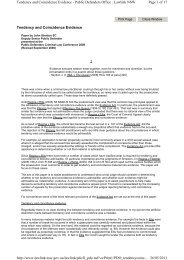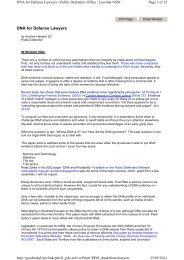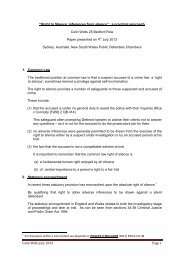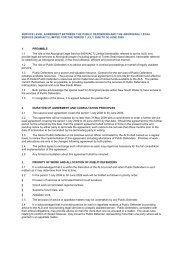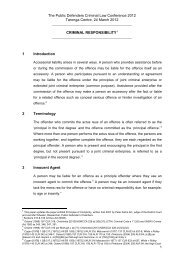Expert Evidence, by Dina Yehia SC - The Public Defenders
Expert Evidence, by Dina Yehia SC - The Public Defenders
Expert Evidence, by Dina Yehia SC - The Public Defenders
Create successful ePaper yourself
Turn your PDF publications into a flip-book with our unique Google optimized e-Paper software.
WOOD v R [2012] NSWCCA<br />
Eleven years after Caroline Byrne died, on 3 May 2006 Gordon Wood (the applicant) was charged and<br />
subsequently convicted of her murder. <strong>The</strong> Crown case was a circumstantial case. <strong>The</strong> allegation was that the<br />
applicant had thrown Ms Byrne off a cliff at the Gap in Sydney. <strong>The</strong> police failed to take photographs of the<br />
body in situ. Some years after her death, there was some controversy over the precise location at which Ms<br />
Byrne’s body was found. <strong>The</strong> location was crucial to the conclusions reached <strong>by</strong> A/Prof Rod Cross about<br />
whether Ms Byrne had jumped or was thrown over the edge.<br />
[461] <strong>The</strong> applicant challenged the evidence and opinions of A/Prof Cross. It was<br />
submitted that his opinion that Ms Byrne had been "spear thrown" from the "northern ledge<br />
of the Gap" was based on a number of "assumptions, experiments and assumed facts." It<br />
was argued that before his evidence could be considered these assumptions had to be<br />
identified and proved <strong>by</strong> admissible evidence: Ramsay v Watson [1961] HCA 65; (1961)<br />
108 CLR 642 at 649; ss 55, 76, 79 and 137 of the <strong>Evidence</strong> Act. It was further argued <strong>by</strong><br />
the applicant that in order for A/Prof Cross' opinions to be probative, the assumptions he<br />
made needed to have a reasonable foundation in evidence and, furthermore, he needed to<br />
be qualified to express the relevant opinions. <strong>The</strong> applicant submitted that since these<br />
conditions were not met the trial miscarried.<br />
[462] <strong>The</strong> applicant submitted that the flawed assumptions accepted <strong>by</strong> A/Prof Cross<br />
related to:<br />
conditions under which A/Prof Cross' experiments were conducted;<br />
the availability of 4 m of run-up on the northern ledge;<br />
the northern ledge being the point of departure;<br />
the 180-degree rotation of Ms Byrne's body;<br />
the applicant's weight being 80 kg, thus enabling him to bench press 100 kg;<br />
the athletic ability of Ms Byrne;<br />
Ms Byrne ending up in hole A; and<br />
the use of a spear throw to throw Ms Byrne off the cliff top.<br />
<strong>The</strong> challenge to the admissibility of A/Prof Cross' evidence at the trial was confined to his<br />
views on the issue of the likelihood of injury being caused to Ms Byrne as she landed on<br />
the rocks at the base of the cliff. Although his evidence was not otherwise challenged,<br />
significant and important aspects of his evidence were concerned with biomechanics,<br />
which required an understanding of the functioning and capacity of the human body. In HG<br />
v <strong>The</strong> Queen [1999] HCA 2; (1999) 197 CLR 414 at [44] Gleeson CJ said:<br />
"<strong>Expert</strong>s who venture 'opinions', (sometimes merely their own inference of fact),<br />
outside their field of specialised knowledge may invest those opinions with a spurious<br />
appearance of authority, and legitimate processes of fact-finding may be subverted."<br />
[467] To my mind A/Prof Cross was allowed, without objection, to express opinions outside<br />
his field of specialized knowledge.<br />
McClellan CJ at CL was critical of the experiments conducted <strong>by</strong> A/Prof Cross at the police academy in<br />
Goulburn using the gymnasium and swimming pool. Female police cadets were thrown into the pool <strong>by</strong> male<br />
officers. <strong>The</strong>y were instructed to cooperate with the thrower. <strong>The</strong>y did not resist or struggle. Although the<br />
subjects simulated being limp in the arms and legs, they cooperated <strong>by</strong> diving out of the throw.<br />
11



